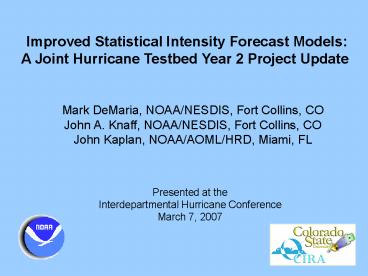Improved Statistical Intensity Forecast Models: - PowerPoint PPT Presentation
Title:
Improved Statistical Intensity Forecast Models:
Description:
Improved Statistical Intensity Forecast Models: A Joint Hurricane Testbed Year 2 ... Statistical-dynamical TC intensity prediction model. 16 ... Intensity ... – PowerPoint PPT presentation
Number of Views:67
Avg rating:3.0/5.0
Title: Improved Statistical Intensity Forecast Models:
1
Improved Statistical Intensity Forecast Models A
Joint Hurricane Testbed Year 2 Project Update
Mark DeMaria, NOAA/NESDIS, Fort Collins, CO John
A. Knaff, NOAA/NESDIS, Fort Collins, CO John
Kaplan, NOAA/AOML/HRD, Miami, FL
Presented at the Interdepartmental Hurricane
Conference March 7, 2007
2
Outline
- Progress on JHT Project Goals
- New decay model in SHIPS
- Modified vertical shear calculation
- New problem in 2006 model
- Discriminant analysis version of the Rapid
Intensity Index - SHIPS and RII for the 2007 Season
3
2006 Operational Version of SHIPS
- Statistical-dynamical TC intensity prediction
model - 16 basic predictors
- atmospheric from GFS forecast fields
- oceanic from Reynolds weekly SST
- climatology and persistence from ATCF input
- Correction for ocean heat content (Atlantic only)
and GOES predictors - previous JHT project
- Adjusted SST from Joe Cione cooling algorithm
- previous JHT project, Atlantic only
- Empirical decay equation over land
4
2006 Rapid Intensity Index
- Uses subset of SHIPS input most correlated with
rapid intensity change - Estimates probability of 25 kt increase in next
24 hours - Original version used 30 kt threshold
- Atlantic and east Pacific versions
- Results included on SHIPS text output
5
Goal 1. Modified Inland WindDecay Algorithm
- Kaplan and DeMaria (1994) inland decay developed
for continental U.S. landfalls - Too much decay for storms over islands and
peninsulas - Modified version where decay rate depends on
fraction of storm circulation over land - Reduces decay rate over islands and narrow land
masses
6
Atlantic SHIPS Improvements with New Decay Model
(2001-2006)
Note No significant impact on East Pacific SHIPS
Goal 1 completed and has been in SHIPS since 2005
7
Goal 2 Improved Shear Calculation
- SHIPS uses NHC official track for center of shear
calculation - GFS vortex track can differ from NHC track
- Shear calculation uses large annulus to
compensate (200-800 km)
8
Example of NHC and GFS Track Mismatch96 h
Forecast for Frances from 27 Aug 2004 12 UTC
850 hPa
200 hPa
O
O
G
G
G GFS position O NHC Position
9
New Shear Algorithm
- Track location of GFS vortex at 850 hPa
- Tracker finds location that maximizes 0 to 600 km
symmetric tangential wind - Checks for reasonable translational speeds
- Requires minimum cyclonic wind
- Symmetric circulation subtracted
- Starts from outer radius where symmetric
circulation is cyclonic - Subtraction radius decreases with height
- Shear calculation at NHC track position after
vortex removed - 0-500 km radius rather than 200-800 km annulus
10
Example of Vortex Removal
Total Wind Symmetric Flow
Residual
850 hPa
200 hPa
11
A New Predictor and Bad Old One
- New Time tendency of GFS mean 850 hPa tangential
circulation - 0 to 600 km average
- Old 850 hPa environmental vorticity
- 0 to 1000 km average
- Measures environment for small storms
- Measures storm circulation for large storm
- Inconsistent predictor with higher resolution GFS
12
SHIPS With New Shear
- Replace 200-800 km shear with 0-500 km shear
(after vortex removal) - Replace 850 hPa environmental vorticity with GFS
vortex time tendency - All 2006 cases re-run with operational input
- Logistic Growth Equation Model (LGEM) also tested
with new shear - Uses time stepping procedure instead of time
averaging of predictors
13
Forecast Impact 2006 Atlantic Re-runs
Forecast Errors
Percent Improvement over
Operational D-SHIPS
14
Forecast Impact 2006 East Pacific Re-runs
Forecast Errors
Percent Improvement over
Operational D-SHIPS
15
Goal 3 Improve theRapid Intensity Index
- Operational version uses 6 scaled input
parameters to estimate the probability of rapid
intensification in the next 24 hours - Improved version
- Use discriminant analysis to determine optimal
weights for combining predictors - Run in real time during 2006 season
- Also tested on larger sample in dependent mode
- RII Probabilities evaluated using Brier Skill
Score
16
2006 RII skill
Atlantic N175 Nri11 Probri 6.3
(climo12) E. Pacific N284 Nri45 probri 15.8
(climo11)
17
RII Skill for the 2003-2005 developmental sample
Atlantic N846 Nri115 Probri13.6
(climo12) E. Pacific N521 Nri59 Probri11.3
(climo11)
18
Proposed Form of 2007 SHIPS and RII
- SHIPS
- Include new decay model
- Replace old shear with new one
- Replace 850 hPa environmental vorticity with 850
hPa GFS vortex circulation predictor - Run LGEM version with new SHIPS predictors
- Additional changes
- Fix Central Pacific domain problem
- Additional GOES data quality control
- RII
- Re-develop discriminant analysis weights with
2006 case - Run equal weights and DA version in 2007































